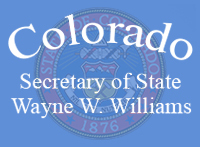Colorado completes first risk-limiting audit ever
Colorado Secretary of State sent this bulletin at 11/22/2017 01:35 PM MST
Having trouble viewing this email? View it as a Web page. ![]()
News Release
Lynn Bartels
Julia Sunny
A new kind of election audit: Colorado is the first to complete it
Photos attached
DENVER, Nov. 22, 2017 -- Now it's in the history books: Colorado has become the first state to complete a "risk-limiting audit" designed to catch mistakes when ballots are tabulated.
The Colorado legislature ordered the use of risk-limiting audits in 2009 -- long before widespread media coverage of fears about hacking election equipment and interference by foreigners -- but the timeline to implement the RLAs was delayed until this year's Nov. 7 coordinated election.
"I think it’s fair to say that both state and county election officials were a little anxious because this has never been done before," Colorado Secretary of State Wayne Williams said. "But it turned out to be an amazing success, and that's because our staff and our county clerks have done a phenomenal job. I am thankful for their hard work and dedication."
The process attracted attention nationwide. Matt Masterson, chairman of the U.S. Election Assistance Commission, and fellow commissioner Thomas Hicks were among those who witnessed the procedure.
"Colorado is a national leader in exploring innovative solutions for accessible, secure and auditable elections," Masterson said. "Colorado’s risk-limiting audit provided great insights into how to conduct more efficient and effective post-election audits. The EAC is eager to share some of the lessons learned with election officials across America."
A risk-limiting audit is a procedure that provides strong statistical evidence that the election outcome is right and has a high probability of correcting a wrong outcome. Risk-limiting audits require human beings to examine and verify more ballots in close races (exactly when you want to examine more ballots), and fewer ballots in races with wide margins. The procedures for conducting risk-limiting audits are spelled out in Secretary of State Election Rule 25.
If you're an in-the-weeds kind of election junkie or math wonk, you might be interested in the results the Secretary of State's office posted on its Audit Center. Under the subheads "Round # 1" and "Round # 2" click on "State report (XLSX)" for a county-by-county review.
Six counties that did not have any issues for the ballot and so held no elections did not participate in this year’s RLA. Neither did Jackson and San Juan counties, which hand count their ballots. For more information on the RLA process, check out the Audit Center.
###
Photo captions
Colorado Secretary of State Wayne Williams explains what’s next after multi-colored 10-sided dice were used Friday, Nov. 17, 2017, to establish a “seed” to randomly select ballots for each county to audit. (SOS photo/Judd Choate)
Local, state and federal election officials as well as election activists and observers, gather for a group shot at the Arapahoe County Clerk and Recorder's election warehouse on Nov. 17, 2017. The participants, including Colorado Secretary of State Wayne Williams and Arapahoe Clerk Matt Crane, helped pull ballots in preparation for the county's ballot tabulation. (Arapahoe County photo)

